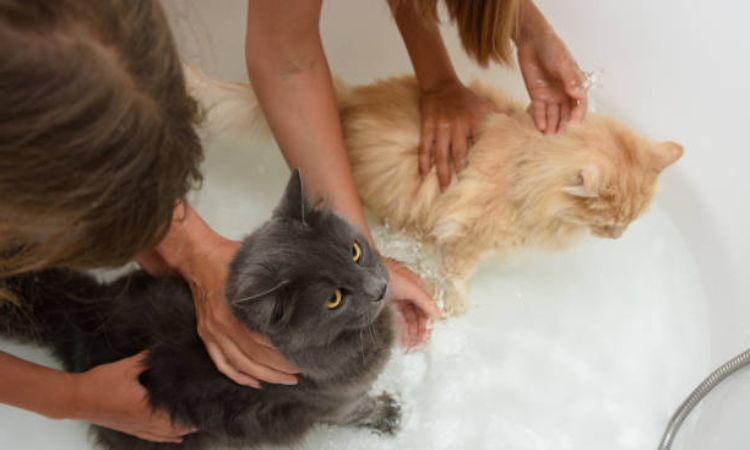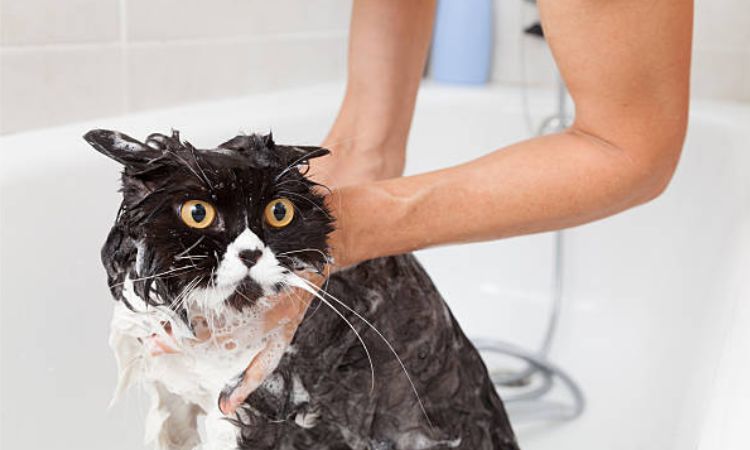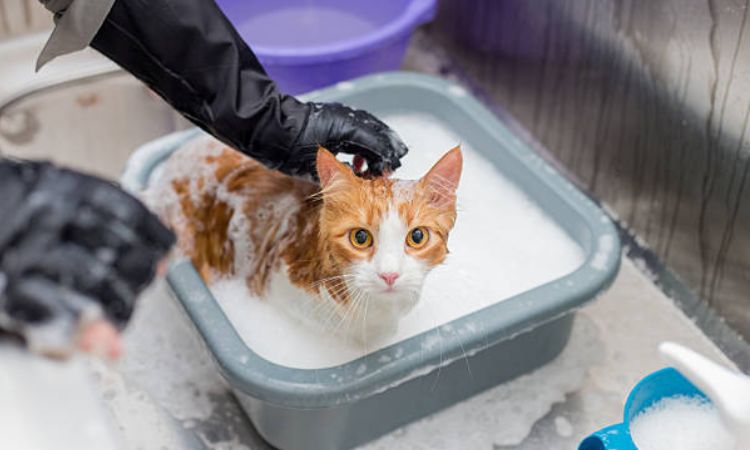Cats are famously fastidious, spending hours grooming themselves to keep their coats spotless—but even the most self-sufficient feline can sometimes benefit from a helping hand. Whether it’s a little extra care for a long-haired breed, a messy accident, or a health-related wash, knowing when and how to bathe your cat can make all the difference.
In this guide, Nexus Pets walks you through everything you need to keep your cat clean, comfortable, and stress-free, without turning bath time into a battle.
Is Bathing Cats Cruel?
Bathing cats is not inherently cruel, but the experience can be stressful if done incorrectly. Cats are naturally fastidious groomers, using their tongues to clean and maintain their coats. For most healthy cats, this self-grooming is sufficient, which is why routine baths are usually unnecessary. However, situations arise—such as exposure to sticky substances, harmful chemicals, or severe matting—where a bath becomes essential for the cat’s health and comfort. In these cases, bathing is an act of care, not cruelty.

The key is preparation. A calm, quiet environment with comfortably warm water, minimal noise, and gentle handling can greatly reduce stress. Using towels, non-slip mats, and cat-specific shampoos, along with positive reinforcement like treats, helps the cat feel safe. Addressing common concerns, such as “Is it cruel to bathe cats at night?”, the timing of the bath matters less than creating a low-stress environment; evening baths are fine if the space is calm and warm.
Understanding the difference between unnecessary bathing and medically or hygienically necessary bathing helps owners provide care without causing harm. Proper technique, patience, and the right environment ensure that bathing remains a safe and compassionate act.
The ‘Why’ and ‘When’ of Cat Bathing
Establishing Baseline Frequency
A common question for cat owners is: “How frequently should I bathe my cat?” or “Can I bathe my cat every 2 weeks?”. For most healthy indoor cats, bathing should be an occasional event rather than routine. Cats are expert self-groomers and spend a significant portion of their day licking their fur to remove dirt, debris, and loose hair.
Over-bathing can strip the coat of natural oils that protect the skin and maintain a shiny, healthy coat. For a typical indoor cat, a bath every few months—or only when absolutely necessary—is usually sufficient. Bathing every two weeks is rarely needed unless your cat has gotten into something particularly messy or odorous.
Scenario 1: Addressing Odor and Dirt
“Should I bathe my cat if he stinks?” Cats can develop unpleasant odors for several reasons, including rolling in dirt, sticky substances, litter box accidents, or occasionally underlying health problems like dental disease or skin infections. For minor messes, spot cleaning with a damp cloth, unscented pet wipes, or waterless shampoo is often enough to freshen up your cat without the stress of a full bath. A complete bath should be reserved for situations where the odor is persistent, strong, or involves substances that your cat cannot clean themselves.
Scenario 2: Handling Parasites (Fleas)
“How often should I bathe my cat with fleas?” Bathing can help remove live fleas, but it is only a temporary solution. Flea-specific shampoos will kill fleas on contact, but they do not prevent reinfestation. Flea control should be combined with veterinarian-recommended spot-on treatments, oral medications, and environmental measures.
When bathing a cat for fleas, use lukewarm water and a pet-safe flea shampoo, lather gently, and rinse thoroughly, avoiding the cat’s eyes and ears. Afterward, dry your cat completely with a soft towel to prevent chilling.
Scenario 3: Skin and Coat Issues (Dandruff)
“Should I bathe my cat if she has dandruff?” Dandruff usually indicates dry skin, not dirt, so frequent bathing is not a solution. Use a moisturizing, oatmeal-based, or prescription shampoo recommended by a veterinarian. Over-bathing can worsen dryness and irritation.
After washing, gently brush the coat to distribute natural oils, remove flakes, and stimulate healthy skin. For cats with ongoing dandruff, follow your vet’s guidance on shampoo frequency and any additional skin treatments.
Scenario 4: Environmental Factors (Heat)
“Should I bathe my cat in hot weather?” Bathing is not an effective way to cool a cat. Cats manage their body temperature differently than humans and are susceptible to heat stress. In hot weather, provide plenty of shade, fresh water, and cool surfaces for them to rest on.
Lightly dampening a towel and gently wiping the cat’s paws or belly can help briefly, but never rely on a full bath as a cooling method. Watch for signs of heat stroke, including panting, drooling, lethargy, or unresponsiveness, and seek immediate veterinary care if these occur.

The Ultimate Step-by-Step ‘How’ Guide
Preparation (The Key to Success)
Before even thinking about wetting your cat, preparation is critical. Gather all your supplies in one place: a cat-specific, hypoallergenic shampoo, several soft towels, cotton balls to gently block the ears from water, and a non-slip mat to prevent slips in the sink or tub. Having everything ready reduces stress for both you and your feline friend.
Trim your cat’s claws beforehand to minimize accidental scratches—safety for you and your cat is paramount. If your cat tends to be nervous or squirmy, consider recruiting a second person to assist. One person can hold or gently soothe the cat while the other handles washing and rinsing.
The Bathing Process
Fill a sink, tub, or basin with lukewarm water, ensuring it is never hot. The water level should not exceed the cat’s legs—submerging a cat can be terrifying and unsafe. Slowly introduce your cat to the water, letting them explore and adjust at their own pace. Gentle handling is key: support their body firmly but softly, and avoid forcing them into the water.
Begin washing from the neck down, carefully avoiding the head and ears. Apply the cat shampoo to a soft, damp cloth or directly to the fur in small amounts, and gently work it through the coat. Focus on areas that need the most attention, like the paws, underbelly, and tail, while maintaining a calm, reassuring tone to keep your cat relaxed.
Rinsing (Critical Step)
Thorough rinsing is essential. Leftover shampoo can irritate a cat’s sensitive skin and cause dryness or itching. Use a cup or gentle spray to rinse all soap residues from the fur, checking multiple times to ensure nothing is missed. Avoid spraying directly into the face, ears, or eyes.
Drying
Once rinsed, remove your cat from the water and immediately begin towel drying. Use several soft, absorbent towels to pat and gently rub the fur, paying special attention to the paws and underbelly.
If your cat tolerates it, you can use a low-heat, quiet blow dryer. Start at a distance and keep the airflow gentle, gradually bringing it closer as the cat becomes comfortable. Never use high heat or force the cat to stay in one place. For most cats, finishing the drying process with towels and allowing them to retreat to a warm, quiet area is sufficient.

Post-Bath Cat Care and Rewards
Towel Drying and Cozy Retreat
After the bath, immediately wrap your cat in a soft, absorbent towel. Pat and gently rub their fur, focusing on areas that hold more moisture like the underbelly, paws, and tail. Allow your cat to retreat to a warm, quiet, draft-free area with clean bedding to finish drying at their own pace. This gives them a sense of security and comfort after the stressful experience.
Monitoring Skin and Coat
Check your cat’s skin and coat for any signs of irritation such as redness, itching, or flaking. Residual shampoo or rough rubbing can sometimes cause sensitivity, so observe them for the next few hours. If you notice persistent redness, swelling, or your cat obsessively licking a certain area, contact your veterinarian.
Brushing and Fur Maintenance
Once mostly dry, gently brush your cat’s coat to remove loose hairs and prevent tangles. This also helps distribute natural oils, keeping the fur shiny and healthy. Long-haired cats especially benefit from a post-bath brushing to avoid matting.
Rewarding Your Cat
Positive reinforcement is critical to reduce bath-related anxiety. Offer your cat favorite treats, gentle praise, or a short play session immediately after bath time. This helps your cat associate the bath with a positive experience, making future baths easier.
Optional: Calm-Down Accessories
Consider pheromone diffusers or sprays to help your cat relax after a bath, especially if they remain tense. Soft, gentle stroking and quiet conversation can also help lower their stress levels. Avoid forcing attention; let them come to you once they feel ready.
Bathing cats is rarely needed, but knowing when and how ensures their health and comfort. Proper preparation, gentle handling, and post-bath care keep your cat safe and stress-free, while brushing or waterless shampoos can maintain cleanliness between baths. These steps help your cat stay clean and comfortable without unnecessary anxiety.






